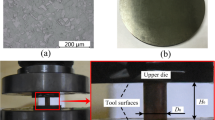Abstract
Due to the size effect phenomenon, the conventional friction models commonly used in metal forming are not accurate for use in micro-metal forming. In this study, the frictional size effect, as one of the most important phenomena in micro-metal forming, has been investigated. Different frictional models developed based on open and closed lubricant pockets theory have been investigated in both dry and lubricated frictional conditions. Those models use a scale parameter to quantify friction on the micro-scale and a real contact area to calculate the friction force at contacting surface. The models were implemented into ABAQUS finite element package via the VFRIC_COEF subroutine interface. The ring compression test with specimens of different sizes was used to determine the parameters of the models. By reducing the dimensions of the specimens in the ring compression test, no size effect was observed in dry friction conditions. However, in the lubricated frictional conditions, it was observed that the coefficient of friction increased significantly with reducing the specimen size. As the dimensions of the specimen decrease and the scale parameter approaches 1, the gap between the coefficient of friction curves increases significantly, and the coefficient of friction converges to those obtained in dry friction conditions.

















Similar content being viewed by others
References
Engel U, Eckstein R (2002) Microforming—from basic research to its realization. J Mater Process Technol 125:35–44
Vollertsen F, Behrens G, Wielage H, et al (2013) Sheet Metal Forming. In: Micro Metal Forming. Springer, pp 135–176 https://doi.org/10.1007/978-3-642-30916-8_5
Geiger M, Kleiner M, Eckstein R et al (2001) Microforming. CIRP Ann 50:445–462
Vollertsen FÃ, Niehoff HS, Hu Z (2006) State of the art in micro forming. 46:1172–1179https://doi.org/10.1016/j.ijmachtools.2006.01.033
Fu MW, Chan WL (2014) Micro-scaled products development via microforming. Springer, London
Grueebler R, Hora P (2009) Temperature dependent friction modeling for sheet metal forming. Int J Mater Form 2:251. https://doi.org/10.1007/s12289-009-0548-z
Merklein M, Koch J, Schneider T et al (2010) Manufacturing of complex functional components with variants by using a new metal forming process – sheet-bulk metal forming. Int J Mater Form 3:347–350. https://doi.org/10.1007/s12289-010-0778-0
Han J, Zheng W, Wang G, Yu M (2018) Experimental study on size effect of dry friction in meso/micro-upsetting process. Int J Adv Manuf Technol 95:1127–1133. https://doi.org/10.1007/s00170-017-1291-0
Han J, Lin Y, Zheng W, Wang G (2020) Experimental and numerical investigations on size effect of friction in meso-/micro-forming without lubricant. Int J Adv Manuf Technol 106:4869–4877. https://doi.org/10.1007/s00170-020-04959-x
Eriksen RS, Weidel S, Hansen HN (2010) Tribological influence of tool surface roughness within microforming. Int J Mater Form 3:419–422. https://doi.org/10.1007/s12289-010-0796-y
Jiang Z, Zhao J, Lu H et al (2017) Influences of temperature and grain size on the material deformability in microforming process. Int J Mater Form 10:753–764. https://doi.org/10.1007/s12289-016-1317-4
Messner A, Engel U, Kals R, Vollertsen F (1994) Size effect in the FE-simulation of micro-forming processes. J Mater Process Technol 45:371–376
Gau J, Principe C, Wang J (2007) An experimental study on size effects on flow stress and formability of aluminm and brass for microforming. 184:42–46https://doi.org/10.1016/j.jmatprotec.2006.11.003
Chan WL, Fu MW, Lu J (2011) The size effect on micro deformation behaviour in micro-scale plastic deformation. Mater Des 32:198–206. https://doi.org/10.1016/j.matdes.2010.06.011
Wan W, Lv P, Liu F et al (2023) Evaluation of interfacial friction characteristics in multi-mode ultrasonic vibration assisted micro-extrusion process. J Manuf Process 88:12–21. https://doi.org/10.1016/j.jmapro.2023.01.033
Shahrokh R, Ghaei A, Farzin M, Ahmadi F (2018) Experimental and numerical investigation of ultrasonically assisted micro-ring compression test. Int J Adv Manuf Technol 95:3487–3495
Wanheim T, Bay N, Petersen AS (1974) A theoretically determined model for friction in metal working processes. Wear 28:251–258
Nellemann T, Bay N, Wanheim T (1977) Real area of contact and friction stress—the role of trapped lubricant. Wear 43:45–53
Engel U (2006) Tribology in microforming. Wear 260:265–273
Wang C, Guo B, Shan D et al (2014) Tribological behaviors in microforming considering microscopically trapped lubricant at contact interface. Int J Adv Manuf Technol 71:2083–2090
Peng L, Lai X, Lee H et al (2010) Friction behavior modeling and analysis in micro / meso scale metal forming process. Mater Des 31:1953–1961. https://doi.org/10.1016/j.matdes.2009.10.040
Bay N (1987) Friction stress and normal stress in bulk metal-forming processes. J Mech Work Technol 14:203–223. https://doi.org/10.1016/0378-3804(87)90061-1
Gerved G (1985) Analyse af friktions-og trykfordeling ved stukning. In: MM report No. 85. 13, Technical University of Denmark (in Danish)
Male A (1964) A method for the determination of the coefficient of friction of metals under conditions of bulk plastic deformation. J Inst Met 93:38
Avitzur B (1968) Metal forming: Processes and analysis. McGraw-Hill Book Co., McGrawHill, New York, NY
Ka I, Movrin D, Ivaniševi A (2011) One Contribution to the Friction. 36:. https://doi.org/10.2478/v10211-011-0001-4
Funding
The authors declare that no funds, grants, or other support were received during the preparation of this manuscript.
Author information
Authors and Affiliations
Corresponding author
Ethics declarations
Competing Interests
The authors declare they have no known competing financial interests.
Additional information
Publisher's Note
Springer Nature remains neutral with regard to jurisdictional claims in published maps and institutional affiliations.
Rights and permissions
Springer Nature or its licensor (e.g. a society or other partner) holds exclusive rights to this article under a publishing agreement with the author(s) or other rightsholder(s); author self-archiving of the accepted manuscript version of this article is solely governed by the terms of such publishing agreement and applicable law.
About this article
Cite this article
Alidoust, A., Ghaei, A. Experimental and numerical study of frictional size effects in micro-metal forming. Int J Mater Form 16, 67 (2023). https://doi.org/10.1007/s12289-023-01789-6
Received:
Accepted:
Published:
DOI: https://doi.org/10.1007/s12289-023-01789-6



